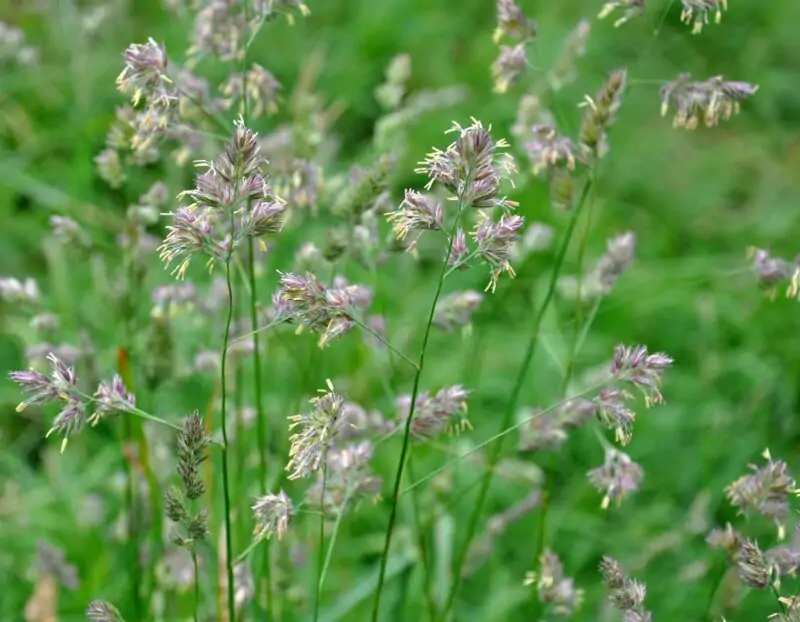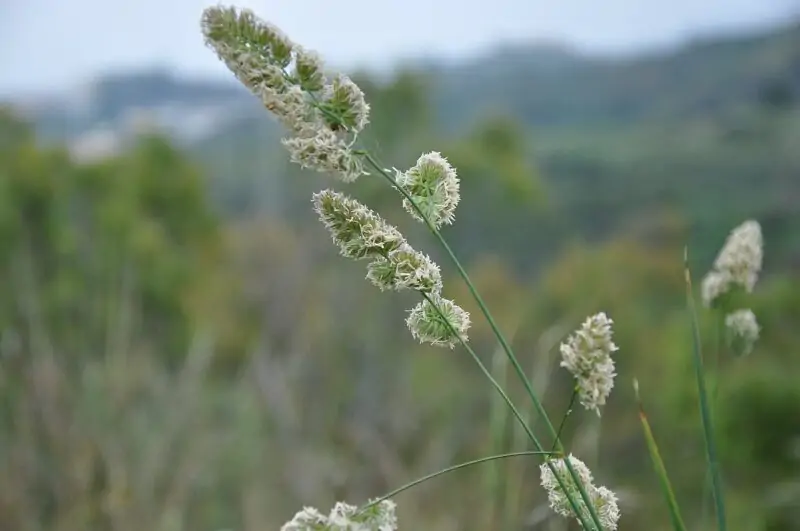What is Orchard Grass (Dactylis glomerata): A Vital Forage Grass for Orchards

Ever wondered, “what is orchard grass?” I’m here to introduce you to the wonderful world of orchard grass, a resilient perennial grass adored by farmers and grazers alike. From its humble roots in Eurasia to its now global presence, this cool-season, bunch-type grass has a story to tell. And trust me, it’s more exciting than you’d think!
The Fundamentals: What is Orchard Grass
Now, let’s get to the juicy stuff! Orchard grass, scientifically known as Dactylis Glomerata L., is a cool-season grass native to our old friend, Eurasia. But don’t let that fool you into thinking it’s not a globe-trotter. This perennial bunch grass has spread its leaf blades far and wide, setting root in pastures around the world.
Beloved for its adaptability, orchard grass thrives on a variety of soils. From clay to gravely loams, shallow to deep soils, this grass doesn’t discriminate. It’s not even picky about water, growing well in areas with high water tables. Talk about a real team player!
What’s more, orchard grass is more than just a pretty leaf blade. It’s a pasture powerhouse, widely used in seeding due to its resilient nature. Whether you’re seeding a stand-alone field or partnering it with alfalfa, orchard grass delivers.
Importance of Orchard Grass in Agriculture
Alright, why should you care about orchard grass? This leafy wonder is a star in the agriculture scene. Known for its palatability, it’s like a salad bar for a variety of livestock classes. From cows to sheep, animals can’t resist this nutritious buffet.
Because it’s a perennial grass, it keeps coming back year after year, providing a reliable source of feed. It also plays a key role in rotational grazing systems and can handle heavy grazing. That means even after a horde of hungry animals have had their fill, this tenacious grass bounces back.
And let’s not forget its role in soil health. Orchard grass is not just a feast for the eyes and animals, it’s a boon for the ground too. Paired with legumes like alfalfa or red clover, it helps enrich the soil, making your pasture or field more fertile.
Understanding Dactylis Glomerata: The Scientific Side of Orchardgrass

Overview of Dactylis Glomerata
It’s time to don our lab coats and dig into the science of orchard grass, or as the botanists call it, Dactylis Glomerata L. This cool-season grass has some cool features. The leaf blade is v-shaped and folded in the bud, while its ligules are membranous.
From a fresh spring sprout to a mature plant in late summer, every stage of Dactylis Glomerata is a spectacle. It grows up to 18 inches high, and its spikelets are neatly arranged on one side of the branch. From the research fields of Purdue University to orchardgrass-legume mixtures in local fields, you can witness its fascinating lifecycle.
Ecological Importance and Role in Ecosystems
Now, our grassy friend isn’t just about looks or food. It plays an important ecological role too. Orchard grass helps improve and stabilize the soil, preventing erosion. Its roots delve deep, binding the soil together.
And when paired with legumes, such as alfalfa or red clover, it assists in nitrogen fixation. This process enriches the soil, promoting the growth of other plants. Plus, as a cool-season bunchgrass, orchard grass provides shelter and food for wildlife, adding to the biodiversity.
Distinctive Characteristics of Dactylis Glomerata
In the cool season, cumulus grows in tufts, unlike grasses that use rhizomes to propagate. Instead, this bunch type grass relies on a multitude of seedlings, ensuring its legacy.
Its leaf sheath is tightly wrapped around the stem, and it has a membranous ligule (a thin outgrowth) at the base. The panicle, the loose branching part of the plant, is also a telltale sign you’re dealing with orchard grass. All these features make orchard grass a unique variety in the world of grasses.
The Significance of Orchardgrass Seed
The Reproductive Role of Orchardgrass Seed
The orchardgrass seed plays a significant role in the propagation of this plant. During early spring, once the conditions are right, orchard grass begins its reproductive phase. Its panicle shoots up and starts producing seeds, ensuring the next generation of seedlings is ready to sprout when the time is right.
The germination process, from seed to seedling, requires just the right balance of moisture, light, and temperature. But since orchardgrass is such a hardy plant, it doesn’t ask for much. Give it a decent seedbed, a sprinkle of water, and some warm sunlight, and you’ll see a flurry of orchardgrass seedlings in no time.
Varieties of Orchardgrass Seed
There is a variety of orchardgrass seed available, each suited for specific growing conditions and needs. Some are early maturing, perfect for areas with short growing seasons. Others are more tolerant to drought, ideal for areas prone to dry periods.
Selecting the right variety is crucial for the best results. If you’re looking for a high-yield, easy-to-establish, and durable grass, orchardgrass might be just the ticket. It’s not only versatile but also compatible with legumes, making it a great choice for diverse pastures.
Factors Affecting Orchardgrass Seed Production
Like all crops, orchardgrass seed production depends on a variety of factors. Soil fertility, seeding rate, and even the choice of seed variety can impact the amount and quality of seeds produced. Orchardgrass responds well to good fertility, so applying appropriate rates of N (nitrogen) can significantly boost your seed production.
Seeding Techniques for Orchardgrass
Preparing the Soil for Seeding
So, you’ve decided to seed some orchard grass. Great choice! The first step is to prepare the soil. You’ll want to start by creating a fine seedbed, as it provides the best conditions for germination. Clear the area of any debris and rake it smooth. A well-prepared seedbed is like a cozy nursery for your orchardgrass seed.
Ideal Seeding Time and Conditions
When to seed is just as important as how to seed. The best time for seeding orchardgrass is early in the spring or late summer. This cool-season grass prefers temperatures between 4 to 6 degrees Celsius for germination. Make sure the soil is moist, but not waterlogged. Seedlings need water to grow, but too much can cause them to rot.
Effective Seeding Methods for Orchardgrass
For the actual seeding, you can use grain drills or broadcast seeding. Both methods work well, but using grain drills ensures more uniform seed distribution and depth. The seeding rate varies depending on the mixture. For pure stands of orchardgrass, 10 to 12 kg per hectare is often recommended, while for orchardgrass-legume mixtures, 4 to 6 kg per hectare is enough.
Post-Seeding Care and Maintenance
Orchardgrass requires care and attention after seeding. Post-seeding management is crucial for the growth and development of the grass. You should graze fields heavily and frequently to promote tillering and prevent the orchard grass from maturing too quickly.
Regular grazing also maintains palatability, as it encourages the grass to produce fresh, tender leaves. Just remember not to overgraze, as this could stress the plants and deplete root reserves, which are essential for the grass’s survival, especially during periods of drought.
FAQs About Orchard Grass
Orchard grass performs well on different textured soils ranging from clay to gravely loams and on shallow to deep soils. Even saline soils and areas with high water tables are no match for this resilient grass. So whether your field is more like a desert or a swamp, orchard grass has you covered.
To maximize the yield of your orchardgrass crop, you should apply good fertility practices. Orchardgrass responds well to fertility, especially nitrogen. Regular applications of nitrogen can result in increased growth, which in turn leads to higher yields.
Additionally, make sure to practice rotational grazing. This gives your grass time to rest and recover between grazing periods, which can lead to healthier, more productive plants.
Orchardgrass is one tough plant. It can thrive in a range of climatic conditions, from cool, damp springs to hot, dry summers. This hardiness is part of what makes it such a popular choice for pasture and hay production.
But that’s not to say it’s indestructible. Extended periods of drought or extreme cold can damage the grass, so it’s important to provide adequate water and consider cover during particularly harsh weather.
Like all plants, orchardgrass can be affected by a number of pests and diseases. Common problems include leaf spot, rust, and aphids. Fortunately, with good management practices, these issues can be kept under control. Regular inspection, prompt treatment at the first sign of trouble, and maintaining a healthy, balanced ecosystem can help ensure your orchardgrass stays in top shape.
Conclusion
So, what is orchard grass? It’s a versatile, resilient, and productive plant, making it a favorite among farmers and grazers. We’ve explored its scientific side, the importance of its seeds, and the methods for seeding and maintaining this valuable plant.
From the benefits it brings to pastures and the agricultural industry, to the unique characteristics that set it apart, orchardgrass truly stands out in the world of grasses. Whether you’re a seasoned farmer or just starting out, knowing about orchardgrass can be a valuable addition to your agricultural knowledge. The production of orchardgrass, from seeding to grazing, is a journey worth undertaking.